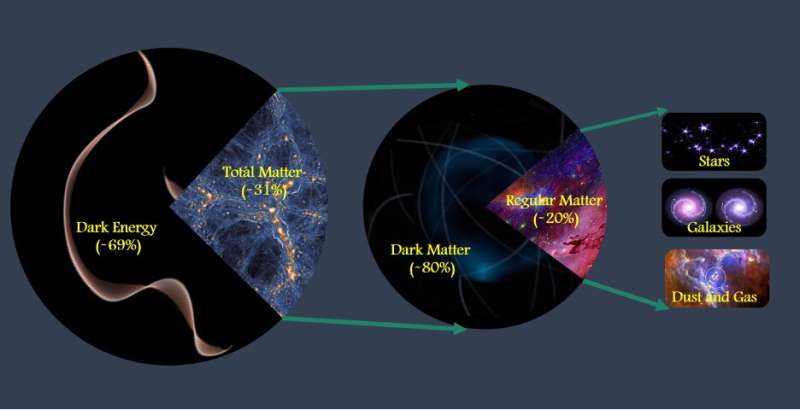Scientists precisely measure total amount of matter in the universe

A top goal in cosmology is to precisely measure the total amount of matter in the universe, a daunting exercise for even the most mathematically proficient. A team led by scientists at the University of California, Riverside, has now done just that.
Reporting in the Astrophysical Journal, the team determined that matter makes up 31% of the total amount of matter and energy in the universe, with the remainder consisting of dark energy.
"To put that amount of matter in context, if all the matter in the universe were spread out evenly across space, it would correspond to an average mass density equal to only about six hydrogen atoms per cubic meter," said first author Mohamed Abdullah, a graduate student in the UCR Department of Physics and Astronomy. "However, since we know 80% of matter is actually dark matter, in reality, most of this matter consists not of hydrogen atoms but rather of a type of matter which cosmologists don't yet understand."
Abdullah explained that one well-proven technique for determining the total amount of matter in the universe is to compare the observed number and mass of galaxy clusters per unit volume with predictions from numerical simulations. Because present-day galaxy clusters have formed from matter that has collapsed over billions of years under its own gravity, the number of clusters observed at the present time is very sensitive to cosmological conditions and, in particular, the total amount of matter.

"A higher percentage of matter would result in more clusters," Abdullah said. "The 'Goldilocks' challenge for our team was to measure the number of clusters and then determine which answer was 'just right.' But it is difficult to measure the mass of any galaxy cluster accurately because most of the matter is dark so we can't see it with telescopes."
To overcome this difficulty, the UCR-led team of astronomers first developed "GalWeight", a cosmological tool to measure the mass of a galaxy cluster using the orbits of its member galaxies. The researchers then applied their tool to observations from the Sloan Digital Sky Survey (SDSS) to create "GalWCat19," a publicly available catalog of galaxy clusters. Finally, they compared the number of clusters in their new catalog with simulations to determine the total amount of matter in the universe.
"We have succeeded in making one of the most precise measurements ever made using the galaxy cluster technique," said coauthor Gillian Wilson, a professor of physics and astronomy at UCR in whose lab Abdullah works. "Moreover, this is the first use of the galaxy orbit technique which has obtained a value in agreement with those obtained by teams who used noncluster techniques such as cosmic microwave background anisotropies, baryon acoustic oscillations, Type Ia supernovae, or gravitational lensing."
"A huge advantage of using our GalWeight galaxy orbit technique was that our team was able to determine a mass for each cluster individually rather than rely on more indirect, statistical methods," said the third coauthor Anatoly Klypin, an expert in numerical simulations and cosmology.
By combining their measurement with those from the other teams that used different techniques, the UCR-led team was able to determine a best combined value, concluding that matter makes up 31.5±1.3% of the total amount of matter and energy in the universe.
The research paper is titled "Cosmological Constraints on Ωm and σ8 from Cluster Abundances using the GalWCat19 Optical-spectroscopic SDSS Catalog."
More information: Mohamed H. Abdullah et al, Cosmological Constraints on Ω m and σ 8 from Cluster Abundances Using the GalWCat19 Optical-spectroscopic SDSS Catalog, The Astrophysical Journal (2020). DOI: 10.3847/1538-4357/aba619
Journal information: Astrophysical Journal
Provided by University of California - Riverside




















